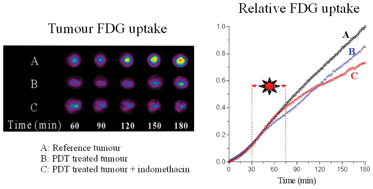Deciphering PDT-induced inflammatory responses using real-time FDG-PET in a mouse tumour model
Abstract
Dynamic positron emission tomography (PET), combined with constant infusion of 2-deoxy-2-[18F]fluoro-D-glucose (FDG), enables real-time monitoring of transient metabolic changes in vivo, which can serve to understand the underlying physiology. Here we investigated characteristic changes in the tumour FDG-uptake profiles in relation to acute localized inflammatory responses induced by photodynamic therapy (PDT). Dynamic PET imaging with constant FDG infusion was used with EMT-6 tumour bearing mice. FDG time-activity uptake curves were measured simultaneously, in treated and reference tumours, for 3 hours, before, during and after PDT light treatment. Inflammation was studied when evoked, either by PDT using a trisulfonated porphyrazine photosensitizer, or lipopolysaccharide (LPS), and inhibited using indomethacin. The distinct transient patterns, characterized by drops and subsequent recovery of tumour FDG uptake rates, were also analysed using immunohistochemical markers for apoptosis, necrosis, and inflammation. Typical profiles for tumour FDG-uptake, consisted of a drop during PDT, followed by a gradual recovery period. Tumours treated with LPS, but not with light, showed a continuous increase in FDG-uptake during the 3 h experimental period. Treatment with indomethacin, inhibited the rise in FDG-uptake observed with either LPS or PDT. Tumour FDG-uptake profiles correlated with necrosis markers during PDT, and inflammatory response markers post-PDT, but not with an apoptosis marker at any time during or after PDT. Dynamic FDG-PET imaging combined with indomethacin reveals that, the drop in the tumour FDG-uptake rate during the PDT illumination phase reflects vascular collapse and necrosis, while the increased tumour FDG-uptake rate immediately post-illumination involves an acute localized inflammatory response. Dynamic FDG infusion and PET imaging, combined with the use of selective inhibitors, provides unique insight for deciphering the complex underlying processes leading to tumour response in PDT, and allows for rapid as well as cost effective optimization of PDT protocols.


 Please wait while we load your content...
Please wait while we load your content...